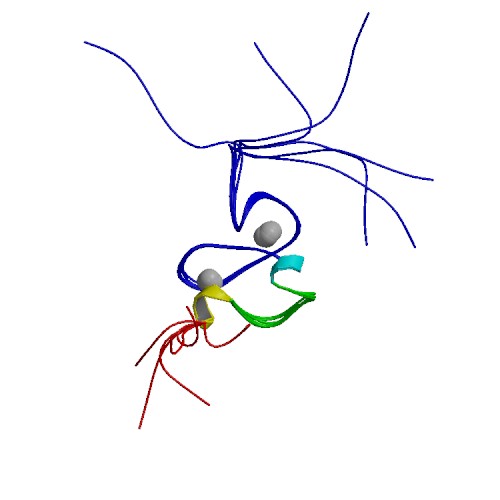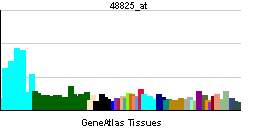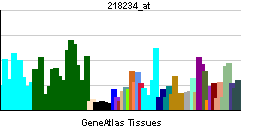ING4
| Inhibitor of growth family, member 4 | |||||||||||||
|---|---|---|---|---|---|---|---|---|---|---|---|---|---|
 PDB rendering based on 1wen. | |||||||||||||
| |||||||||||||
| Identifiers | |||||||||||||
| Symbols | ING4 ; MGC12557; my036; p29ING4 | ||||||||||||
| External IDs | Template:OMIM5 Template:MGI HomoloGene: 22952 | ||||||||||||
| |||||||||||||
| RNA expression pattern | |||||||||||||
 | |||||||||||||
 | |||||||||||||
| More reference expression data | |||||||||||||
| Orthologs | |||||||||||||
| Template:GNF Ortholog box | |||||||||||||
| Species | Human | Mouse | |||||||||||
| Entrez | n/a | n/a | |||||||||||
| Ensembl | n/a | n/a | |||||||||||
| UniProt | n/a | n/a | |||||||||||
| RefSeq (mRNA) | n/a | n/a | |||||||||||
| RefSeq (protein) | n/a | n/a | |||||||||||
| Location (UCSC) | n/a | n/a | |||||||||||
| PubMed search | n/a | n/a | |||||||||||
Inhibitor of growth family, member 4, also known as ING4, is a human gene.[1]
The protein encoded by this gene is similar to ING1, a tumor suppressor protein that can interact with TP53, inhibit cell growth, and induce apoptosis. This protein contains a PHD-finger, which is a common motif in proteins involved in chromatin remodeling. This protein can bind TP53 and EP300/p300, a component of the histone acetyl transferase complex, suggesting its involvement in the TP53-dependent regulatory pathway. Alternatively spliced transcript variants have been observed, but the biological validity of them has not been determined.[1]
References
Further reading
- Ozer A, Bruick RK (2006). "Regulation of HIF by prolyl hydroxylases: recruitment of the candidate tumor suppressor protein ING4". Cell Cycle. 4 (9): 1153–6. PMID 16096374.
- Bonaldo MF, Lennon G, Soares MB (1997). "Normalization and subtraction: two approaches to facilitate gene discovery". Genome Res. 6 (9): 791–806. PMID 8889548.
- Hu RM, Han ZG, Song HD; et al. (2000). "Gene expression profiling in the human hypothalamus-pituitary-adrenal axis and full-length cDNA cloning". Proc. Natl. Acad. Sci. U.S.A. 97 (17): 9543–8. doi:10.1073/pnas.160270997. PMID 10931946.
- Strausberg RL, Feingold EA, Grouse LH; et al. (2003). "Generation and initial analysis of more than 15,000 full-length human and mouse cDNA sequences". Proc. Natl. Acad. Sci. U.S.A. 99 (26): 16899–903. doi:10.1073/pnas.242603899. PMID 12477932.
- Shiseki M, Nagashima M, Pedeux RM; et al. (2003). "p29ING4 and p28ING5 bind to p53 and p300, and enhance p53 activity". Cancer Res. 63 (10): 2373–8. PMID 12750254.
- Garkavtsev I, Kozin SV, Chernova O; et al. (2004). "The candidate tumour suppressor protein ING4 regulates brain tumour growth and angiogenesis". Nature. 428 (6980): 328–32. doi:10.1038/nature02329. PMID 15029197.
- Zhang X, Xu LS, Wang ZQ; et al. (2004). "ING4 induces G2/M cell cycle arrest and enhances the chemosensitivity to DNA-damage agents in HepG2 cells". FEBS Lett. 570 (1–3): 7–12. doi:10.1016/j.febslet.2004.06.010. PMID 15251430.
- Gerhard DS, Wagner L, Feingold EA; et al. (2004). "The status, quality, and expansion of the NIH full-length cDNA project: the Mammalian Gene Collection (MGC)". Genome Res. 14 (10B): 2121–7. doi:10.1101/gr.2596504. PMID 15489334.
- Kim S, Chin K, Gray JW, Bishop JM (2004). "A screen for genes that suppress loss of contact inhibition: identification of ING4 as a candidate tumor suppressor gene in human cancer". Proc. Natl. Acad. Sci. U.S.A. 101 (46): 16251–6. doi:10.1073/pnas.0407158101. PMID 15528276.
- Zhang X, Wang KS, Wang ZQ; et al. (2005). "Nuclear localization signal of ING4 plays a key role in its binding to p53". Biochem. Biophys. Res. Commun. 331 (4): 1032–8. doi:10.1016/j.bbrc.2005.04.023. PMID 15882981.
- Ozer A, Wu LC, Bruick RK (2005). "The candidate tumor suppressor ING4 represses activation of the hypoxia inducible factor (HIF)". Proc. Natl. Acad. Sci. U.S.A. 102 (21): 7481–6. doi:10.1073/pnas.0502716102. PMID 15897452.
- Gunduz M, Nagatsuka H, Demircan K; et al. (2005). "Frequent deletion and down-regulation of ING4, a candidate tumor suppressor gene at 12p13, in head and neck squamous cell carcinomas". Gene. 356: 109–17. doi:10.1016/j.gene.2005.02.014. PMID 15935570.
- Rual JF, Venkatesan K, Hao T; et al. (2005). "Towards a proteome-scale map of the human protein-protein interaction network". Nature. 437 (7062): 1173–8. doi:10.1038/nature04209. PMID 16189514.
- Kim SC, Sprung R, Chen Y; et al. (2006). "Substrate and functional diversity of lysine acetylation revealed by a proteomics survey". Mol. Cell. 23 (4): 607–18. doi:10.1016/j.molcel.2006.06.026. PMID 16916647.
- Unoki M, Shen JC, Zheng ZM, Harris CC (2006). "Novel splice variants of ING4 and their possible roles in the regulation of cell growth and motility". J. Biol. Chem. 281 (45): 34677–86. doi:10.1074/jbc.M606296200. PMID 16973615.
- Raho G, Miranda C, Tamborini E; et al. (2007). "Detection of novel mRNA splice variants of human ING4 tumor suppressor gene". Oncogene. 26 (36): 5247–57. doi:10.1038/sj.onc.1210335. PMID 17325660.
- Zhang X, Lin DH, Jin Y; et al. (2007). "Inhibitor of growth 4 (ING4) is up-regulated by a low K intake and suppresses renal outer medullary K channels (ROMK) by MAPK stimulation". Proc. Natl. Acad. Sci. U.S.A. 104 (22): 9517–22. doi:10.1073/pnas.0703383104. PMID 17517644.
External links
- ING4+protein,+human at the US National Library of Medicine Medical Subject Headings (MeSH)
| This protein-related article is a stub. You can help Wikipedia by expanding it. |
This article incorporates text from the United States National Library of Medicine, which is in the public domain.